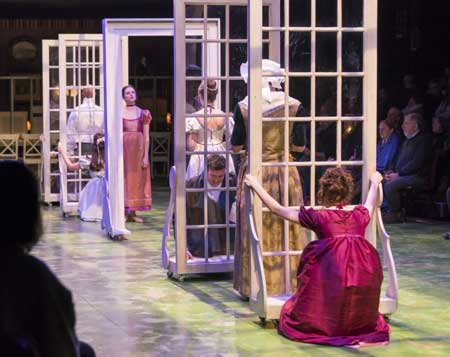Play
by Kate Hamill
Based on the novel Sense and Sensibility (1811) by Jane Austen
Staging and direction by Eric Tucker
Bedlam
American Repertory Theater
Loeb Drama Center
Harvard University, Harvard Square, Cambridge, MA
December 10 – January 14, 2017
Scenic Design: John McDermott; Choreography: Alexandra Beller; Dance Captain: Violeta Picayo
With Jessica Frey (Marianne Dashwood), Maggie Adams McDowell (Elinor Dashwood), Benjamin Russell (John Willoughyby/John Dashwood), Jamie Smithson (Eward/Robert Ferrars/Lad Middleton), Lisa Birnbaum (Mrs. Dashwood/AnneSteele/Mrs. Ferrars), Nigel Gore (Mrs. Jennings), Katie Hartke (Fanny Ferrars Sashwood/Lucy Steele/Lady Middleton), James Patrick Nelson (Colonel Brandon/Thomas/Lady Middleton), Violeta Picayo (Margaret Dashwood), Ryan Quinn (Sir John Middleton/Servant/Doctor)

and the cast
of “Sense and Sensibility”
Photo: Ashley Garrett
Courtesy of Bedlam and American Repertory Theater
The Dashwood girls, Elinor (Maggie Adams McDowell) and Marianne (Jessica Frey), have, along with their recently widowed mother, Mrs. Dashwood (Lisa Birnbaum), been displaced from their respectable home by arcane laws of inheritance and are resituated in a cottage in the country. Marianne has her heart set on John Willoughby (Benjamin Russell) and Elinor has hers on Edward Ferrars (Jamie Smithson) but things get complicated. Meanwhile, Colonel Brandon (James Patrick Nelson), an older, gentler presence, shows up to offer friendship and support while Marianne pines and Elinor withdraws stoically. It’s ultimately a comedy of manners, so things don’t turn out so badly.
This wonderfully animated production rides high on its ingenious staging and choreography which miraculously swirl and flip characters and scenes with an incredible sleight of hand. Actors play multiple characters, sometimes donning a tiara to make a distinction, or suddenly creating a grizzled voice. There is one magnificent scene in which two young women come to visit two old women and the same actors play both, racing across from one end of the stage two the other in magically friction-free chairs. The chairs are a staple of the production and all kinds of wizardry erupts from them. Catapulted out, they swing in just the right manner, seeming to land with magical accuracy.
Windows, as well, play a big role in the scenery configurations, which continually involve characters porting the windows around, sometimes creating central domiciles, and at other times all lining up at one end of the stage to create the sense of a guarded anteroom. It’s all a tremendous amount of fun.
The actors all do a perfectly fine job, but the staging is so dramatic, witty and enveloping that the acting generally takes a back seat to it. It is a pleasure to see Nigel Gore, famous for his collaborations with Tina Packer in the evocative and compendious Shakespearean survey Women of Will, play Mrs. Jennings, wildly histrionic to the hilt, all in good fun and in keeping with the general demeanor of the production.
Bedlam gives, true to its name, a crazily kinetic interpretation of the story, demanding a good amount of awareness on the part of the audience, or at least some considerable preparation on the narrative. It’s not always clear which actor is playing whom, nor does it seem to matter that much. The emphasis of this production is its endless kinetic quality, its movement, which yields an interesting and new interpretation to the story.
Austen’s world, though humorous, has its vividly dramatic qualities, and it’s the combination of Austin’s winking eye and the sympathetic and emotionally evocative renditions of the main characters that makes for her particularly interesting and appealing brew. Nineteenth century mores and expectations, particularly for women, prevail in those narratives and lead to a certain sense of social settledness, if not stagnation. This production emphasizes that wink of the eye and the velocity of its unsettling gesture in the face of that nineteenth century traditionalism, and pulls back from the more austerely dramatic elements of the story.
The show begins with the cast doing a terrific, and terrifically hang-loose, group dance to contemporary music, and the show ends that way as well. Sandwiched within its two wild dances is a nod to the staidness of the former era, the enveloping wildness suggesting Bedlam’s intent to shake those settled things up. Taking a clue from Austen’s humorous poke at the mores of the time, this production improvises on those and lets the world unravel before our eyes. The result is a kind of hilarious pandemonium in which respectability and feeling show themselves as a glimpse cast outwards from a partitioned epoch. But what lives, and what gets magnified out of that nineteenth century diorama, is the wonderful sense of vital humor that Austen offers and which Bedlam swings around the room until one gets dizzy with delight.
– BADMan
Leave a Reply